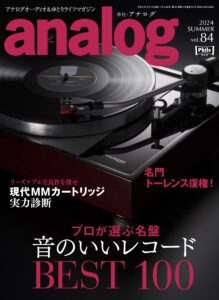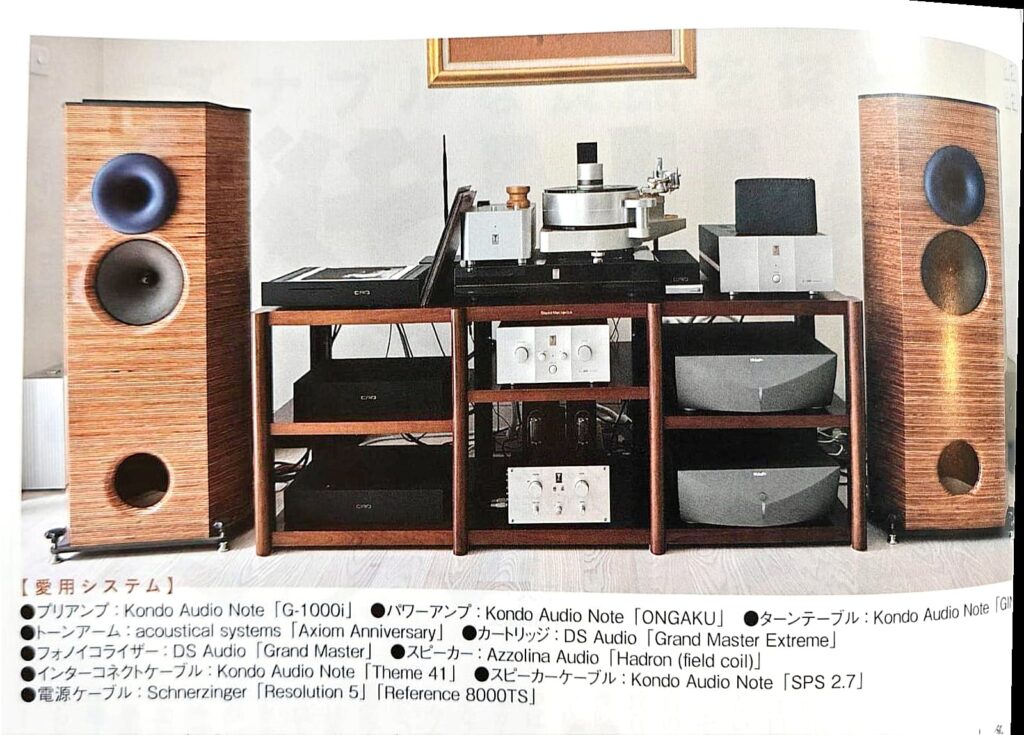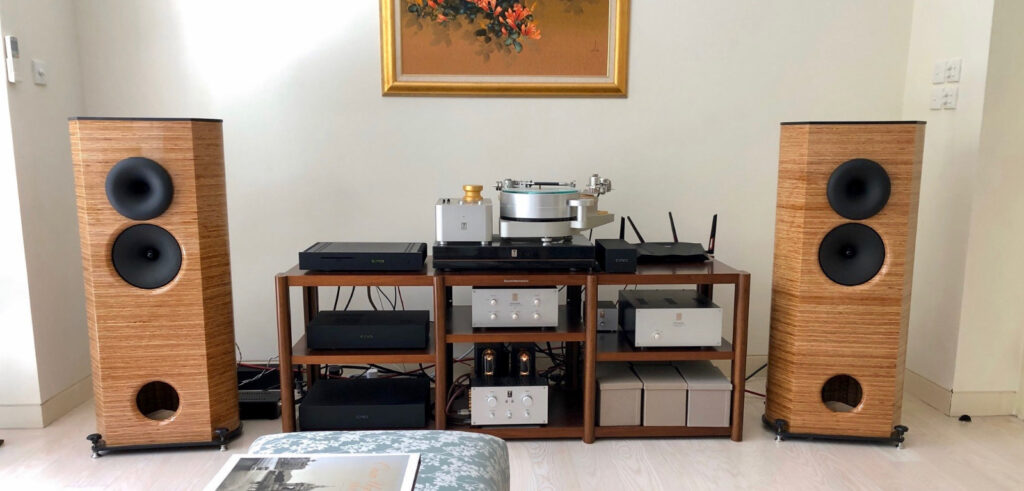Reviews
The Hadron featured in the japanese publication Analog.
“Galibier, Karna, Azzolina – Located in one of the big corner rooms was a system composed of a Galibier Design Stelvio ($12,500) turntable with Triplanar arm and Dynavector XV-1s. The phono stage and preamp were one-off designs, amplification from Karna Push Pull 300B amps from nutshellhifi.com. The speakers were Azzolina Audio Grand Sfera. Cables by Chimera Labs. I played my audiophile approved Sara K., then the Pete Townshend track. Since no one else had any other vinyl to play, I played the Nirvana cut. All the other attendees present left the room, but several more people came into the room and sat down with big smiles on their faces. After Nirvana I played The Eurythmics and Judas Priest to more smiles. So what did I hear from these five LPs. The Sara K. is a true audiophile recording – superbly recorded and pressed. What I heard was like her sitting and singing right there in the room with me. Very nice. On the Pete Townshend track I heard every detail, every movement of his fingers. Quite a toe tapping performance. Kurt Cobain’s voice on the Nirvana cut was not quite as realistic as in the Walker room, but still very nice. The Eurythmics track is heavily mixed. On a high resolution system you can hear each separate track of the mix. I heard all of the tracks. Turbo Lover is actually fairly well recorded and pressed, but I played it just for fun. Judas Priest sure beats hearing Jazz at the Pawnshop for the thousandth time.”
“Thom Mackris of turntable manufacturer Galibier Design (whose Stelvio costs $12,500) had me smiling when he played a hilarious track by Red Knuckles & the Trailblazers. Although a little raucous on top, the system (Schröder Reference SQ tonearm, perversely entitled ZYX Universe cartridge, Artemis Labs PH-1 phono stage, preproduction Karna push-pull 300B 15W amp from Nutshell Hi Fidelity, and Gran Sfera Horns by Azzolina Audio) offered a compellingly huge, all-enveloping, elevated soundstage coupled to a beautiful midrange.
One room over from Galibier, and again sporting imposing Azzolina Audio speakers, Hagerman Audio was showing another all-analog system. With no time to tune the system due to emergency equipment repairs necessitated by shipping damage, the system offered wonderful size and considerable midrange beauty, nonetheless.”
“In a large suite Azzolina Audio was showing their horn-loaded full-range Gran Sfera. Using the Galibier Stelvio turntable as a source, I was impressed by how delicate and detailed the sound was, and yet by the power as well. Superb stuff…”
“…I also had my first exposure to the Azzolinas. These are odd beasts, from a technical standpoint. … A very unusual combination of techniques. Only it wasn’t just a lark, these things really work. The quickness and direct connectedness improved with the dynamics and slam of a horn. They didn’t sound like horns, much of the expected coloration was missing, no shouting or honkiness. … Bass was equally efficient and tuneful.
The sound was excellent. The Azzolinas made my room. These speakers are terrific, and they mate to the CYMBALs like bread and butter. They coasted at maybe 1/2 watt or less most of the time, and having the extra headroom and low output impedance keep everything in control. Dynamics were punchy. I’ve never heard a cone/box speaker do this before. Very open, extremely clear. We also got lucky with room placement. The sound was already there. Focus, a soundstage way behind the speakers.
The Azzolinas were set up so we played LPs into the night.”
“More Azzolinas were next door with a Galibier turntable. Good music, good sound – what more could one want?”
“Shortly after purchasing the Gran Sferas, I wrote…, expressing my great pleasure of owning these fine speakers,… to relate to you a few of my observations following several hundred hours of listening.
1) The location of musicians and vocalists can be precisely identified on any decently recorded music. Even the movements of musicians and their instruments during a piece of music can be detected!
2) The sound stage is incredibly deep. On many recordings done on large stages, it is easy hear the tympani, the trumpets, the horns, or whatever instruments are 20 feet behind the forward instruments, as if they are actually 20 feet behind the instruments on the front of the stage.
3) The width of the sound stage is almost as realistic as the depth. Even though my dedicated listening room is only 12 feet wide, the speakers easily place instruments and singers way beyond the width of my room when the recording calls for that placement.
4) The timbre of instruments and the reality of the human voice is stunning. Though I don’t consider myself an expert in the evaluation of audio systems, my wife and I do attend dozens of live performances yearly, including opera, orchestra, small chamber groups, choirs, small jazz groups, brass bands, rock bands, and more. My mom was a piano performance major; my brother has a masters degree in piano performance; my son and daughter were piano and violin performance majors respectively at the UMKC Conservatory of Music in Kansas City. My point is, I do have a good grasp of the sound of live music. After my brother, the piano player/professional musician, listened to Diana Krall sing to him in my listening room, he had goosebumps on his skin and was speechless–literally, speechless!
5) The dynamic capability of your speakers is fantastic. Thirty years ago I built a couple pair of Speakerlab corner horns–the Klipsch copies. It has been a long time since I sold my personal pair, but the dynamics and the ability of the Gran Sferas to capture the energy of music is at least as good as my corner horns. The first time I listened to Bill Berry (For Duke), I would have sworn that he had come back to life and was playing in my listening room! It sounded as if he was playing his trumpet in my home–the rest of the band was there too!
6) Music simply sounds more real on my system than any other system I have heard. I have listened to a number of audio systems costing two, three, and even four times the cost of mine, but none even remotely approaches the level of reality that my system, anchored by the Gran Sferas, does…
Thanks for making music so enjoyble to me! I never dreamed I would have such fine music making in my home!”
– Doug Smith
“As you know, I am not a fan of the fairly popular Audio theory of mixing the “Tones” of various pieces of audio equipment to achieve a high performance level that accurately reproduces the sound of Live Music. I want transparency…..I want that audio device to be invisible, so it lets the Music flow through without changing it.
As I listened to your Loudspeakers, the first thing I noticed was how quickly I got “sucked” into the Music. My feet were tapping; I would have got up and danced if I would have been by myself. It was Live Music in all its Glory and I was THERE! And I had no plans to leave.
How did the Basso and Alto interact? To be honest, I didn’t think any 15″ driver could keep up with the (horn) drivers. When we listened to Katie Melua’s Piece By Piece, tracks 2 and 4, the difference was amazing. Mid-bass, upper bass and lower midrange performance was outstanding. Best string bass reproduction I have ever heard. I was astounded how accurate the voices of the instruments were. The transition frequency range from the 15″ driver to the Lowther was seamless and undetectable.
Then there were the Susana Baca tracks that showed me that speed and 105dB sensitivity could accurately and effortlessly reproduce the challenging percussion…Rhythm, Pace and Dynamics. These are three of my favorite things and, in my opinion the hardest to achieve.
I am sure you can tell that I am still pumped about how they sound with any type of Music, in both vinyl and disc. I don’t think I have ever heard a more accurate or transparent reproduction.
In one sentence, in my opinion, your Loudspeakers are one of the finest I have ever heard.”
– Dennis Boyle – Chimera Labs
“Serendipitously, I discovered Azzolina in my quest for new speakers for our Galibier turntable demonstration room.
In one sense, I consider my decision to use Azzolina Gran Sfera speakers to be stacking the deck, because the speakers’ resolution level as well as their compatibility with all types of music rival that of my analog front end. One could argue that demonstrating with such a system presents an unfair advantage. My clients have however come to expect nothing less of a system I assemble for demonstration purposes, so the decision to go with Azzolina was an easy one.
As a small, boutique manufacturer, I don’t have the room to store multiple reference speaker systems. The speakers I choose have to do it all – to the extent that this is possible. They must play to a wide range of musical tastes. Additionally, people should be able to relate to them – irrespective of whether their home system is based on dynamic box speakers (cones ‘n domes), open baffle architecture, electrostatics, or horns. I am a firm believer that the best expressions of various architectures will converge on musical truth and that the experienced listener will recognize quality when they hear it.
Over the few months I’ve been running the Azzolina Gran Sfera’s, I’ve received comments like “these don’t sound like horns”. I interpret these statements to mean that they don’t have typical horn coloration’s such as “honk” and other inconsonant resonance. They certainly have room-filling dynamics to the point of being frightening, scale the presentation correctly (large works sound large, and small ones are intimate), and have an immediacy and low-level nuance characteristic of the best horn systems.
Having worked with Azzolina for these short few months, I made the decision to make their speakers available through Galibier Design.
Small, boutique manufacturers occupy a rare position in the audio world. On one hand, we realize that our products need to have universality (which I consider both our turntables as well as the Azzolinas to have). On the other hand, we realize that the very top echelon of equipment requires painstaking system matching and configuration in order to achieve world-class sound.
This latter point is where we as boutique manufacturers hold the trump card over a conventional hi-fi distribution network. It is virtually impossible to lay 5 components from each equipment category in front of a competent audio dealer and expect him to build even one single world-class system from the components. They will likely achieve very, very good “sound” but will fail to achieve greatness and results will not stir the soul.
Achieving greatness in a music reproduction system results from equal amounts of hard work, perseverance and luck. As a result, many boutique manufacturers adopt a model of assembling a single system – one they have invested years in configuring. If you change one component, its performance can easily degenerate into something so pedestrian as to “only” receive a product of the year award from the popular audio press.
From my experience of the Azzolinas, it’s obvious that they share my philosophy – that great sound is merely the departure point on the road to musical greatness. Furthermore, they are well on their way. Listen to these speakers only if you’re ready to get out your checkbook. Resistance is futile.”
“It has taken me almost 1 year to write a report on these bass units. First of all I must thank Charlie for his patience and all these years of support in this endless madness of Hi Fi. Our history goes way back. By the time we got in touch (this time) it was a discussion about the LeCleac’h flare. Fast forward like 6 years… Quick summary of my speakers: AER MD3 drivers mounted on Azura Horns naturally cutting off at 204Hz married with the Basso bass units in 160 litre bass cabinets. The horns are driven with Yamamoto A-08s which give out a whopping 2W, the drivers are 106db alone and the front horn takes them to 110db or there about. The Basso bass units are currently driven with Restek Thorens which are 50W mosfets and Toshiba fets with FRAKO caps. Crossover is a kit from Borisaudio using LeCleach theory, no expense spared with Jensen PIO silver lead outs caps, 24 of them, SPU is all back gates – all resistors are RMG. Pre-amp is Supratek Cortese. My front end has many variations, heavily modified slate Lenco, Garrard 301, SP10 MK2 just to name my main current players. Digital – which I don’t take too seriously as I am a vinyl freak. Carts – too many to name here which includes my own modified version of the Denon 103R (MIDAS).
Before I bought the Basso from Charlie, I had the Klipsch K33-E which were known as a good bass driver and were used in the La Scala bass units. When the Basso arrived, I noticed the difference, the weight of the frames, the weight of the speaker – you could feel the quality immediately! After several emails between Charlie and myself he calculated that I could produce 30Hz bass with 160 litres in my living room. That was sufficient for my requirements.
I have a transparent system, the horns are not shy and many who have electrostatics claim they have the best transparency only to be shocked what these horns can do – not perfect, but refined and dynamic and really hit like you are there. Micro dynamics are almost unmatched. So when I was told that the Basso would improve the clarity of my system, I was puzzled. Charlie explained the need for extremely clean bass. Can it get better? Well, yes! When I installed the Basso I noticed improvement in all registers, everything had cleaned up, not only bass but also the mid range and possibly even the treble. It sounds crazy but it demonstrates how a bass unit not only rolls over, but can colour your system. Charlie informed me that the speaker will improve in 150 to 200 hrs. but will only break in after 1000 hrs. Unreal.
So one year later on, what can I hear? Bass does go down to 30Hz because this is what I can hear from the test CD I have. The lower level registers are clean, picking up everything. It has allowed me to even fine tune my turntable to reduce further any unwanted lower motor noise I could pick up with my front end. The Basso kicks bass like I have never heard, only the very best 15 inch bass units can compare, these are like TADs, possibly the B&W drivers or you can go for the legendary Altecs, but I have never heard texture like these. What I mean by texture, listen to Witches brew RCA Living Stereo Danse Macabre, you will hear even at the beginning the roll of big drums at the back… the background is clear and dark and pickup the music scores being moved, shuffling, the lot. If you have the CD – the Reference Recording Mephisto version, the recording is more modern date – make sure you bolt down everything as when the drum rolls and are hit, its like canons going off! Elgar Pomp and Circumstance – Marches 1 1956 EMI recording, the drums go so low, you can feel the waves. On Moonight Serenade with Ray Brown & L.Almeida track 1, Ray Brown can be heard giving you the full texture of his double bass, unreal, you can hear the big man grunt as he gets to grip towards the end of the track pushing with all his might!
Never mind other bass from other pieces of music, the pick up is quiet spectacular yet it does not colour the upper registers. I urge anyone who is serious not only in bass, but serious in clarity and reproduction to consider this driver.”
– David Wong – Horn Enthusiast
“Azzolina’s QUARK speakers were a real discovery. First of all, their size is very modest; they fit easily into the listening room without having to compromise on a large space. The three-legged stand adds finesse, elegance, and lightness.
The triode amplifier paired with the QUARKs is a marvel to listen to. The speakers produce dynamic sound across all levels of the listening spectrum. The sound is playful, refined, light, and always clear. The ability of these small speakers to reproduce such a sound is impressive, both in terms of their sonic dynamics and the pleasure of listening to them. The emotion is always there, sometimes when I least expect it. Charles has a unique approach to designing systems; he has developed an expertise that gives a system genius. I don’t dare to imagine what the higher-end designs can produce, but for now I still have to work hard to acquire them!”
– Luc Debrousses


